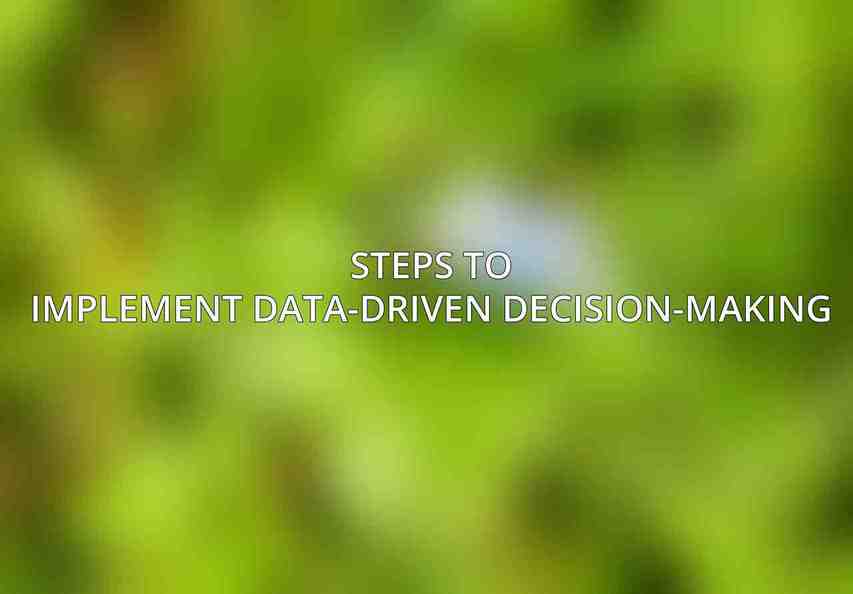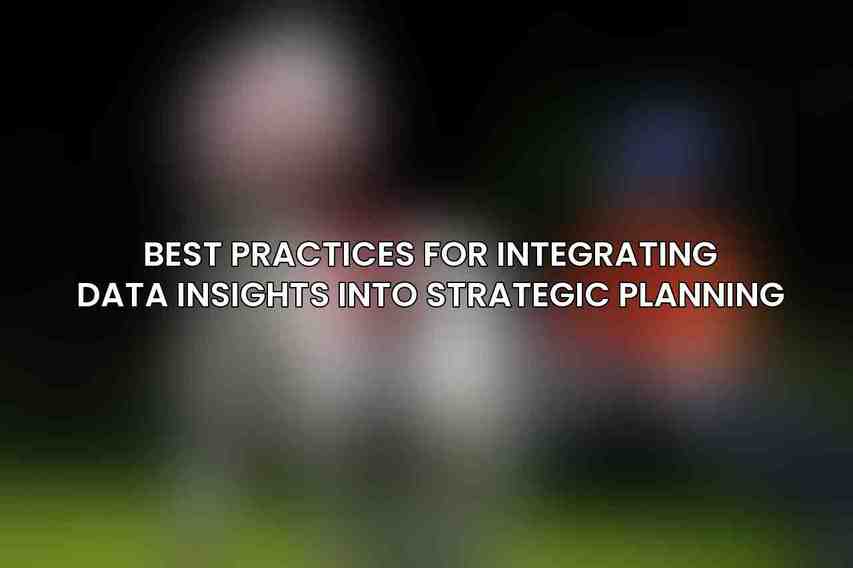Data-driven decision-making is the process of making operational or strategic decisions based on data analysis and interpretation rather than intuition or personal experience alone. In this rapidly evolving business world, where information is abundant and easily accessible, leveraging data has become a critical aspect of ensuring organizational success. By harnessing the power of data, companies can gain valuable insights that guide their decision-making processes, optimize operations, and drive innovation. Implementing best practices in data-driven decision-making can offer a competitive edge, enhance performance, and foster growth.
Steps to Implement Data-Driven Decision-Making

A. Establish a clear data governance strategy
- Define data sources and ownership: Identifying the origin and custodian of data is essential for maintaining its integrity and reliability.
- Establish data quality standards: Setting standards for data accuracy, completeness, consistency, and timeliness ensures that decision-makers have access to reliable information.
- Implement data security measures: Protecting data from breaches and unauthorized access safeguards sensitive information and maintains trust with stakeholders.
B. Build a data-literate organization
- Train employees on data analysis and interpretation: Providing training programs on data analytics tools and techniques equips employees with the skills to extract meaningful insights from data.
- Foster a culture of data-sharing and collaboration: Encouraging open communication and knowledge exchange around data promotes a collaborative environment that values data-driven decision-making.
C. Identify and prioritize key business questions
- Determine which decisions need to be informed by data: Prioritizing business areas where data can drive impactful decisions streamlines the data collection and analysis process.
- Articulate SMART objectives: Setting specific, measurable, achievable, relevant, and time-bound objectives ensures that data-driven initiatives remain focused and aligned with organizational goals.
D. Collect and analyze relevant data
- Identify appropriate data sources: Utilizing both internal data repositories and external sources ensures a comprehensive understanding of the factors influencing decision-making.
- Use data analysis techniques to uncover insights: Employing statistical analysis, data mining, and machine learning methods reveals patterns and trends within the data.
- Visualize data to communicate findings effectively: Presenting data visually through charts, graphs, and dashboards makes complex information more accessible and facilitates decision-making.
E. Develop and implement data-driven solutions
- Generate evidence-based recommendations: Drawing conclusions from data analysis and formulating recommendations based on empirical evidence strengthens the decision-making process.
- Develop and execute action plans: Translating insights into actionable strategies and initiatives aligns organizational efforts with data-driven objectives.
- Monitor results and adjust strategies as needed: Continuously tracking performance metrics, evaluating outcomes, and refining strategies based on data feedback ensures ongoing improvement and agility.
Best Practices for Integrating Data Insights into Strategic Planning

A. Align data analysis with strategic goals
Incorporating data analysis into the strategic planning process ensures that decisions are guided by insights that support long-term objectives. You can find more information on Real-World Success: Analytics Best Practices Case Studies
B. Use data to inform scenario planning and risk assessment
By leveraging data to model different scenarios and assess risks, organizations can proactively plan for contingencies and optimize resource allocation.
C. Create a data-driven performance management system
Establishing key performance indicators (KPIs) backed by data insights allows organizations to track progress, identify areas for improvement, and drive accountability.
D. Establish a continuous improvement process
By regularly reviewing and optimizing data-driven processes, organizations can adapt to changing market dynamics, enhance efficiency, and drive innovation.
E. Foster a culture of innovation and experimentation
Encouraging a culture that values experimentation and learning from data insights promotes creativity, agility, and resilience in the face of uncertainty.
Challenges and Barriers to Implementing Data-Driven Decision-Making
A. Data quality issues
Ensuring data accuracy, consistency, and relevance poses challenges that can impact the effectiveness of data-driven decision-making initiatives.
B. Lack of data literacy
A workforce that lacks proficiency in data analysis and interpretation may struggle to derive meaningful insights from data, hindering informed decision-making. Dive deeper into Mastering Advanced Analytics Techniques
C. Resistance to change
Organizational resistance to adopting a data-driven approach can impede progress and limit the integration of data insights into decision-making processes.
D. Organizational silos
Data silos within departments or teams can inhibit data sharing and collaboration, leading to fragmented insights and suboptimal decision-making. Read more about this on Essential Analytics Tools: Choosing the Right Ones
E. Ethical considerations
Navigating ethical dilemmas related to data privacy, security, and bias requires organizations to establish robust ethical frameworks to guide their data-driven decision-making practices.
Case Studies and Success Stories
A. Example of a company that successfully implemented data-driven decision-making
Company X, a retail giant, faced challenges in optimizing its product mix and pricing strategies. By implementing a data-driven approach, they were able to analyze customer preferences, streamline inventory management, and personalize marketing campaigns. Through targeted data analysis and agile decision-making, Company X achieved a significant increase in sales revenue, improved customer satisfaction, and enhanced operational efficiency.
B. Additional case studies from various industries
- The healthcare sector leveraging data analytics to enhance patient care and treatment outcomes.
- The financial industry using predictive analytics to manage risks and improve investment decisions.
- The technology sector harnessing big data to drive product innovation and customer engagement.
embracing data-driven decision-making and implementing best practices outlined here can revolutionize how organizations operate, innovate, and thrive in this competitive world. By following a structured approach to data governance, fostering a data-literate culture, and integrating data insights into strategic planning, businesses can realize the transformative potential of data-driven decision-making. Continuous commitment to improvement and a proactive stance towards overcoming challenges can position organizations for sustainable success in a data-driven world. As businesses evolve, the ability to harness data effectively will be a key differentiator in unlocking growth opportunities and staying ahead of the curve.
Frequently Asked Questions
Question 1
What is data-driven decision making?
Answer 1
Data-driven decision making is the process of making organizational decisions based on data and analysis rather than intuition or personal experience. It involves collecting, analyzing, and interpreting data to inform strategic and operational decisions.
Question 2
Why is data-driven decision making important? You can find more information on Mastering Analytics: Introduction to Best Practices
Answer 2
Data-driven decision making is important because it helps organizations make more informed and effective decisions. By leveraging data and analytics, businesses can gain insights into market trends, customer preferences, and performance metrics, leading to better outcomes and increased competitiveness.
Question 3
What are some best practices for implementing data-driven decision making?
Answer 3
Some best practices for implementing data-driven decision making include defining clear objectives, establishing key performance indicators (KPIs), ensuring data quality and accuracy, investing in technology and analytics tools, fostering a data-driven culture, and regularly reviewing and updating data strategies.
Question 4
How can organizations overcome challenges in implementing data-driven decision making?
Answer 4
Organizations can overcome challenges in implementing data-driven decision making by addressing issues such as data silos, poor data quality, lack of data literacy, resistance to change, and inadequate resources. It is important to invest in data governance, training programs, and technological infrastructure to support a data-driven approach.
Question 5
What are the benefits of embracing data-driven decision making?
Answer 5
Embracing data-driven decision making brings several benefits to organizations, including improved decision-making accuracy, enhanced operational efficiency, better risk management, increased innovation and competitiveness, and a deeper understanding of customers and markets. By leveraging data, businesses can drive growth and achieve sustainable success.

